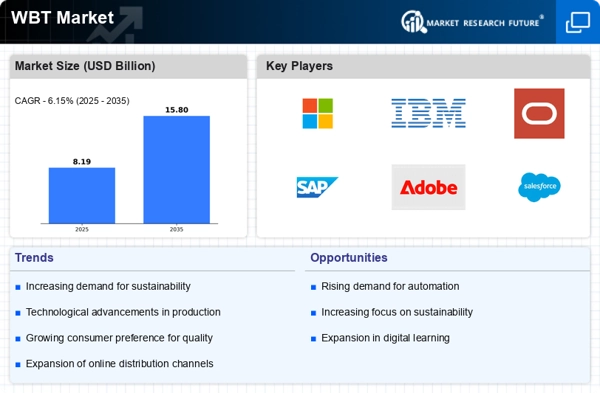The WBT (Web-Based Training) Market is currently characterized by a dynamic competitive landscape, driven by rapid technological advancements and an increasing demand for flexible learning solutions. Major players such as Microsoft (US), IBM (US), and Adobe (US) are strategically positioning themselves through innovation and partnerships, thereby enhancing their operational focus. Microsoft (US) emphasizes cloud-based solutions, integrating AI to personalize learning experiences, while IBM (US) leverages its expertise in analytics to provide data-driven insights for educational institutions. Adobe (US) continues to enhance its creative cloud offerings, focusing on user engagement and content creation, which collectively shapes a competitive environment that prioritizes technological integration and user-centric solutions.
The market structure appears moderately fragmented, with a mix of established players and emerging startups. Key business tactics include localizing content to meet regional needs and optimizing supply chains to ensure timely delivery of educational resources. This competitive structure allows for a diverse range of offerings, catering to various segments of the market, from corporate training to academic institutions, thereby enhancing the overall value proposition for end-users.
In September 2025, Microsoft (US) announced a significant partnership with a leading educational technology firm to enhance its learning management system. This collaboration aims to integrate advanced AI capabilities into their platform, allowing for more personalized learning pathways. The strategic importance of this move lies in Microsoft's commitment to staying at the forefront of educational technology, ensuring that its offerings remain relevant and competitive in a rapidly evolving market.
In August 2025, IBM (US) launched a new suite of AI-driven tools designed specifically for the WBT sector, focusing on adaptive learning technologies. This initiative is particularly noteworthy as it underscores IBM's strategy to leverage its AI capabilities to enhance learning outcomes. By providing institutions with tools that adapt to individual learner needs, IBM positions itself as a leader in educational innovation, potentially reshaping how training is delivered across various sectors.
In July 2025, Adobe (US) expanded its e-learning solutions by introducing new features aimed at enhancing user engagement through interactive content. This strategic move reflects Adobe's focus on creating immersive learning experiences that not only attract users but also retain them. The introduction of these features is likely to strengthen Adobe's competitive edge, as it aligns with the growing demand for engaging and interactive educational content.
As of October 2025, current trends in the WBT Market indicate a strong emphasis on digitalization, sustainability, and the integration of AI technologies. Strategic alliances among key players are increasingly shaping the landscape, fostering innovation and collaboration. The competitive differentiation is likely to evolve from traditional price-based competition to a focus on technological innovation, user experience, and supply chain reliability, suggesting that companies must continuously adapt to maintain their market positions.

















Leave a Comment